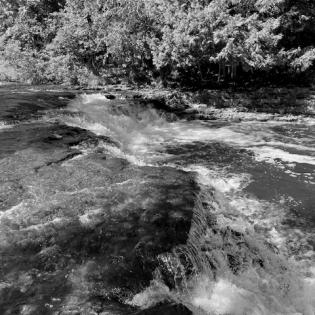Quiet Contamination of Our Waters
Youth learn about the toxic ingredients in personal care products and take action to protect local waterways from the effects of the chemicals.
The learners will be able to
- identify chemicals in personal care products.
- state the harmful effects on the water system of chemicals in pharmaceuticals and personal care products.
- raise awareness of alternatives to allowing chemicals to pollute waterways.
- samples of personal care products
- copy of the PowerPoint slide show to facilitate this lesson (below)
- student copies of Analyzing PCPs handout (below)
Gather a variety of products in advance (hair and skin care, cleansers and moisturizers, nail care, shaving cream)
- Why is it important to protect our community’s water?
- Why do we all need to be good stewards of our environment?
Resources for research work:
- CDC (2016). Prescription Drug Take-Back Day.
- Dispose My Meds (n.d.). You and the Environment.
- Great Lakes Sea Grant Network and Great Lakes Restoration Initiative (n.d.). Help Keep Unwanted Medications & Chemicals Out of the Great Lakes.
- Harvard Health Publications (2011). Drugs in the water.
- Illinois-Indiana Sea Grant and University of Illinois Extension (2017). How to Dispose of Unwanted Medicine & Personal Care Products.
- Minnesota Pollution Control Agency (n.d.). Managing Unwanted Medications.
- New York Department of Environmental Conservation (n.d.). Drugs in New York’s Waters.
- Penn State Extension (2014). Pharmaceutical Disposal and Water Quality.
- World Health Organization (2017). Water Sanitation Hygiene.
Instructions
Adapt this one-period lesson plan for any grade level and follow it with a simple and powerful service project. The reflection brings learning and service impact together.
Anticipatory Set (10 minutes) Ask the learners to quietly brainstorm a written list of products they use in their morning or evening routine? (cleansers, hair products, dental products, cosmetics, moisturizers)
Meet with their lists in small groups and discuss:
- What percentage of the people in your group has read the ingredient labels on their products? Looked them up?
- What chemicals and active ingredients are in these products?
- Where do the chemicals go after you use them?
- How do you think these chemicals affect us and our environment?
As a whole group, review the small group discussion observations.
- Talk about the variety of products we use to improve our appearance or health. Daily medications are called pharmaceuticals (P). Personal care products (PCP) include shampoo, soap, make-up and make-up removers, toothpaste, and moisturizers.
- It is important to us to look and feel good, but we also have to be aware of the impact of our personal choices on others and the environment.
- Ask, "Where do the chemicals in PCPs go when we rinse them down the drain?"
Show the video: The Story of Cosmetics. Discuss the content and solutions from the video.
- Discuss what they can do to be an agent of change related to how pharmaceuticals and personal care products (PPCPs) enter our environment.
- What does it mean to be environmental stewards?
- What is private citizen action for the common good? See the glossary in the handout below.
Learners work in small groups with 2-4 samples of personal care products so they can read and analyze the ingredient labels. They complete the PPCP handout below with information learned about the chemicals that are in the given products.
Discussion Questions:
- What are some common ingredients in your products?
- What is the purpose of those ingredients?
- How do they affect our environment and waterways?
- Brainstorm ways to reduce our use of these PPCPs such as the following:
- Eliminate products you do not really need (or find healthy ways to dispose)
- Purchase or make your own natural products
- Complete and sign a personal “Action Plan- Reducing my PPCP Waste”
Service Project Ideas:
- Create PSAs, memes, or another format to teach people about using safe products for the sake of the environment. Promote the ideas from Part Three, above.
- Work with the local community or nonprofit to create a pharmaceutical “Drop-Off Event.”
- Test local waterways for health levels. Purchase water-testing kits via a science supply company. Lamotte is one brand used by teachers. Test for nitrates, pH, and other chemicals.
- Contact a local "river watch" project that may need help counting critters.
- For younger learners: Write a letter to local leaders about the importance of clean water. Each learner includes a drawing of what they enjoy most about clean water.
- Youth may make their own alternative personal care products like shampoo, conditioner, or face cleanser, and use only those products for one week. Search online for “homemade personal care products.” They can journal about their experience on how easy (or not) and effective the natural products were compared to their store-bought counterparts. Have them consider cost, availability of ingredients, storage issues (lifespan), and time required to make and use.
Philanthropy Framework
-
Strand PHIL.II Philanthropy and Civil Society
-
Standard PCS 01. Self, citizenship, and society
-
Benchmark MS.4 Describe the characteristics of someone who helps others.
-
-
Standard PCS 03. Philanthropy and Economics
-
Benchmark MS.5 Define <i>stewardship</i> as a trust of common resources held by a community for citizens.
-
-
-
Strand PHIL.IV Volunteering and Service
-
Standard VS 01. Needs Assessment
-
Benchmark HS.1 Identify a need in the school, local community, state, nation, or world.
-
-
Standard VS 02. Service and Learning
-
Benchmark MS.1 Select a service project based on interests, abilities and research.
-
-
